In celebration of UCLA’s first 100 years, we’re traveling back in time to visit some of the people, places and moments in time that have had a lasting impression on who we are as a university.
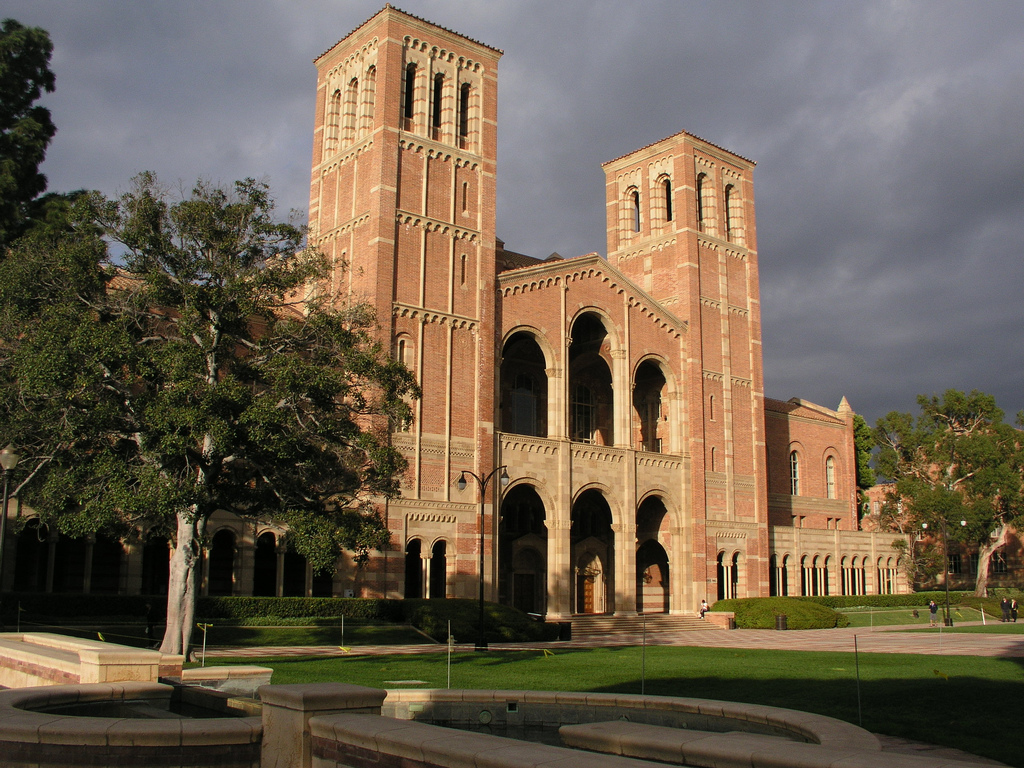

Royce Hall in 2007
The 2000s have been called the age of turbulence — marked by the dot-com crisis, the housing bubble burst and the subprime mortgage crisis, all of which led to the Great Recession. The advent of text messaging and new forms of social media interaction — including Friendster, Myspace and Facebook — changed how we communicate. Students protested against war, UC investment in Sudan, a decline in recruitment of women and minorities following the passage of Proposition 209, passage of the DREAM Act, and rising UC tuition.
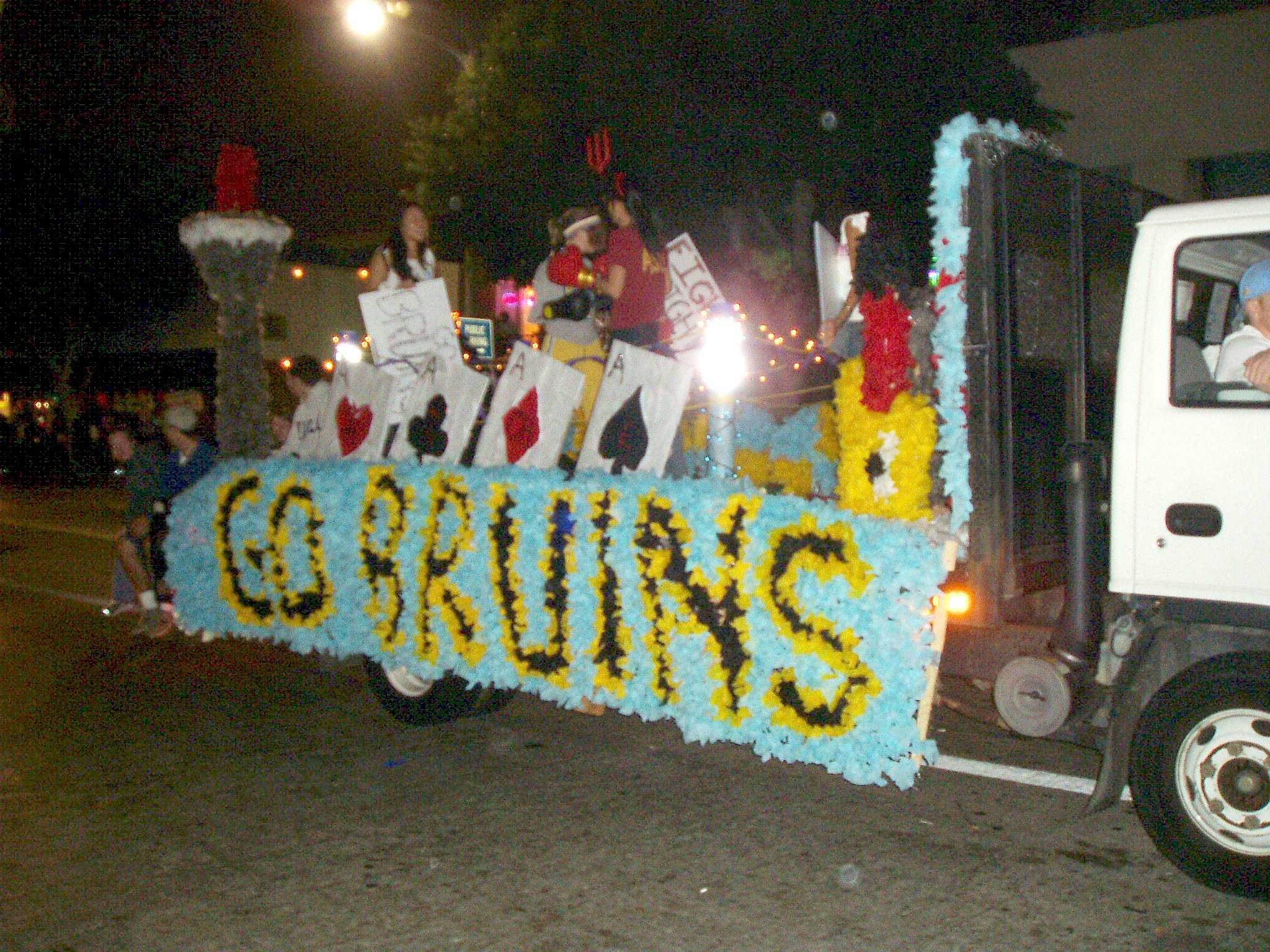 In 2002, many students felt that school spirit had been running low. As part of the solution, UCLA revived homecoming. That fall, after a six-year hiatus, thousands of Bruins gathered in Westwood Village to enjoy KROQ DJs and watch the western-themed parade, “Wild, Wild Westwood.”
Chancellor Albert Carnesale retired in 2006 with a legacy that included doubling funding for UCLA's research programs. UCLA tapped law school faculty member Norman Abrams to serve as interim chancellor. Current chancellor Gene D. Block was inaugurated as the university’s ninth chief executive in May, 2008. In his inaugural address, Chancellor Block spoke of the promise of UCLA saying, “We must ensure that future generations of Californians share in the great dream that we enjoy. We can’t afford to achieve anything less. I’m counting on you as we take steps to propel this great institution through a new age.”
In 2002, many students felt that school spirit had been running low. As part of the solution, UCLA revived homecoming. That fall, after a six-year hiatus, thousands of Bruins gathered in Westwood Village to enjoy KROQ DJs and watch the western-themed parade, “Wild, Wild Westwood.”
Chancellor Albert Carnesale retired in 2006 with a legacy that included doubling funding for UCLA's research programs. UCLA tapped law school faculty member Norman Abrams to serve as interim chancellor. Current chancellor Gene D. Block was inaugurated as the university’s ninth chief executive in May, 2008. In his inaugural address, Chancellor Block spoke of the promise of UCLA saying, “We must ensure that future generations of Californians share in the great dream that we enjoy. We can’t afford to achieve anything less. I’m counting on you as we take steps to propel this great institution through a new age.”
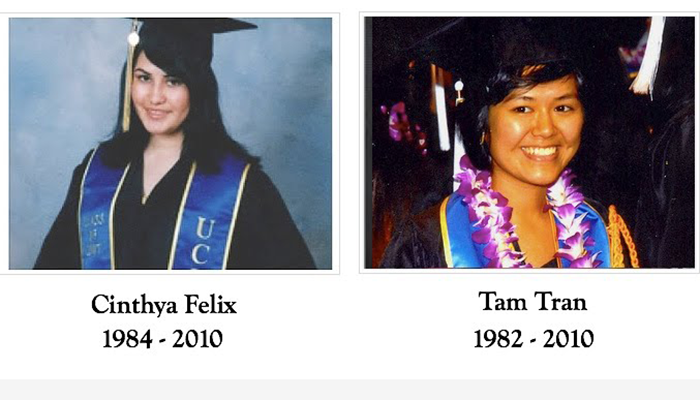 During the 2000s, UCLA students and faculty began organizing advocacy for undocumented students and passage of the DREAM Act, "Development, Relief, and Education for Alien Minors Act." The proposed law would grant citizenship to those who entered the country as children.
UCLA students Tam Tran ‘06 and Cinthya Felix Perez ’07 led the movement for undocumented students’ civil rights. At a time when many were afraid to disclose their citizenship status, Tran and Felix challenged stereotypes and shared their stories. Felix co-founded the student group IDEAS (Improving Dreams, Equality, Access and Success), and Tran testified before Congress in 2007. UCLA students created the video, “Dreamers at UCLA — Pass the DREAM Act,” which was shown before the House Judiciary Committee's Subcommittee on Immigration, Citizenship, Refugees, Border Security and International Law on May 18, 2007. The bill has since been reintroduced several times but has failed to pass. Tragically, they were both killed in a car collision caused by a drunk driver.
During the 2000s, UCLA students and faculty began organizing advocacy for undocumented students and passage of the DREAM Act, "Development, Relief, and Education for Alien Minors Act." The proposed law would grant citizenship to those who entered the country as children.
UCLA students Tam Tran ‘06 and Cinthya Felix Perez ’07 led the movement for undocumented students’ civil rights. At a time when many were afraid to disclose their citizenship status, Tran and Felix challenged stereotypes and shared their stories. Felix co-founded the student group IDEAS (Improving Dreams, Equality, Access and Success), and Tran testified before Congress in 2007. UCLA students created the video, “Dreamers at UCLA — Pass the DREAM Act,” which was shown before the House Judiciary Committee's Subcommittee on Immigration, Citizenship, Refugees, Border Security and International Law on May 18, 2007. The bill has since been reintroduced several times but has failed to pass. Tragically, they were both killed in a car collision caused by a drunk driver.
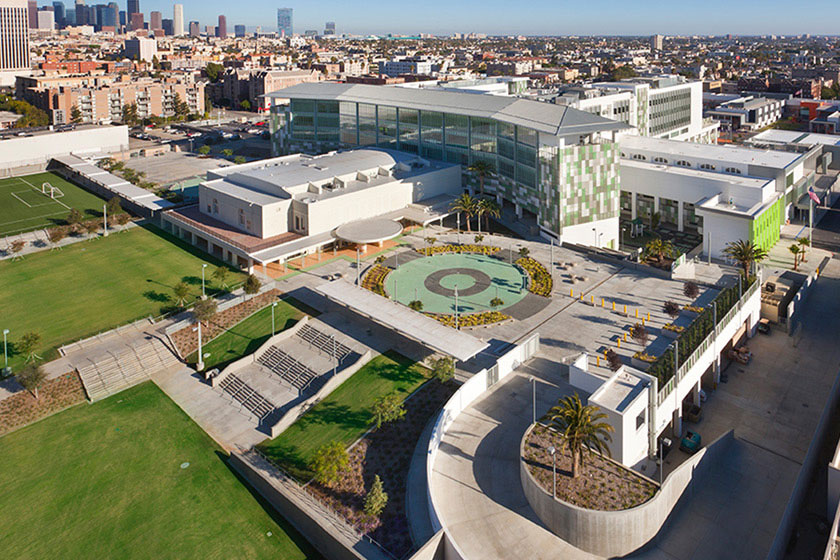 The UCLA Community School, one of 10 locally governed public schools, opened in 2009, on the historic site of the former Ambassador Hotel in the Koreatown-Pico district. Serving primarily Korean- and Spanish-speaking families, the school offers a dual-language, college-prep program. In 2012, the school graduated its first class of seniors, with 81% planning to attend college.
The UCLA Community School, one of 10 locally governed public schools, opened in 2009, on the historic site of the former Ambassador Hotel in the Koreatown-Pico district. Serving primarily Korean- and Spanish-speaking families, the school offers a dual-language, college-prep program. In 2012, the school graduated its first class of seniors, with 81% planning to attend college.
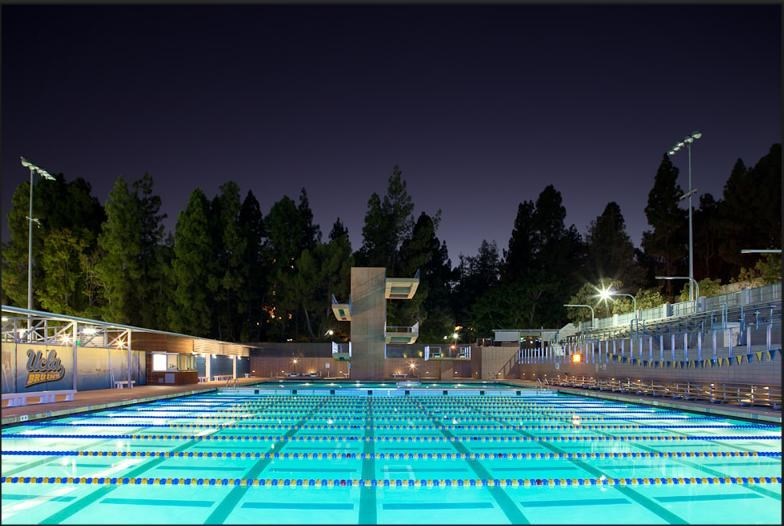 The state-of-the-art Spieker Aquatics Center, named in honor of UCLA All-American swimmer Tod Spieker ’71 and his wife Catherine, opened in 2009 as part of the Sunset Canyon Recreation Center. The ADA facility’s Olympic-size pool and a four-platform diving tower brought varsity and club water polo, swimming and diving teams to the same venue. A "Wall of Champions" celebrates UCLA’s long list of aquatic achievements and Olympic athletes.
The state-of-the-art Spieker Aquatics Center, named in honor of UCLA All-American swimmer Tod Spieker ’71 and his wife Catherine, opened in 2009 as part of the Sunset Canyon Recreation Center. The ADA facility’s Olympic-size pool and a four-platform diving tower brought varsity and club water polo, swimming and diving teams to the same venue. A "Wall of Champions" celebrates UCLA’s long list of aquatic achievements and Olympic athletes.
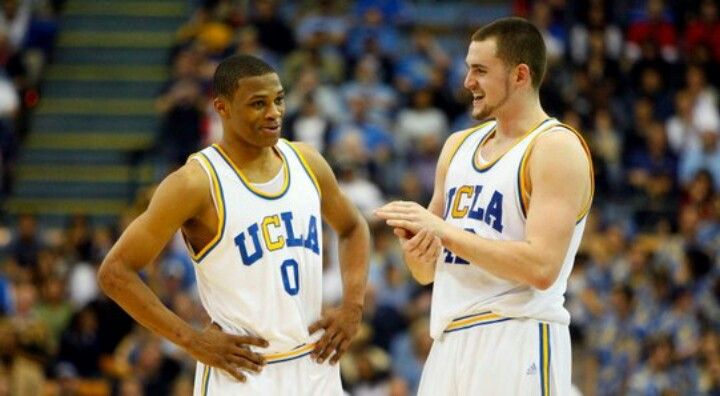 A highlight for the men’s basketball team was the naming of the Pauley Pavilion basketball court the Nell & John Wooden Court in 2003, in honor of the legendary coach and his wife. The team had back-to-back-to-back Final Four appearances from 2006-2008. Several stand-out players played for the Bruins, although many left early for the NBA. Kevin Love was voted the Pac-12 player of the year, Russell Westbrook was Pac-10 Defensive Player of the Year, and Jrue Holiday played for only one year until entering the NBA draft. Holiday married fellow Bruin Lauren Cheney Holiday ’09, the first soccer player in UCLA history to earn All-America First-Team honors all four years. In women’s basketball, Lisa Willis ’06, set the UCLA record for threes in a season (70) and triples in her collegiate career (186), and is also tied for first with Kari Korver ’17 for career 3-point field goals (256). Willis became the first woman to serve as an assistant coach for the Knicks.
A highlight for the men’s basketball team was the naming of the Pauley Pavilion basketball court the Nell & John Wooden Court in 2003, in honor of the legendary coach and his wife. The team had back-to-back-to-back Final Four appearances from 2006-2008. Several stand-out players played for the Bruins, although many left early for the NBA. Kevin Love was voted the Pac-12 player of the year, Russell Westbrook was Pac-10 Defensive Player of the Year, and Jrue Holiday played for only one year until entering the NBA draft. Holiday married fellow Bruin Lauren Cheney Holiday ’09, the first soccer player in UCLA history to earn All-America First-Team honors all four years. In women’s basketball, Lisa Willis ’06, set the UCLA record for threes in a season (70) and triples in her collegiate career (186), and is also tied for first with Kari Korver ’17 for career 3-point field goals (256). Willis became the first woman to serve as an assistant coach for the Knicks.
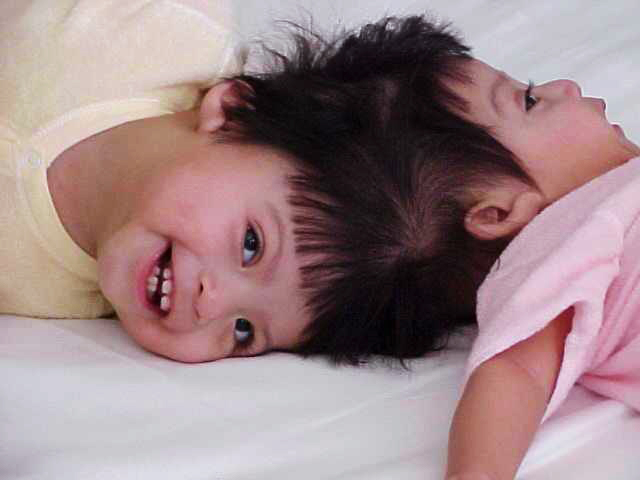 In 2002, people across the globe waited as conjoined twins, Maria de Jesus Quiej (Josie) and Maria Teresa (Teresita) Alvarez were separated by a team of UCLA surgeons, nurses and technicians, many of whom donated their time and services. Nicknamed the “Little Marias” by hospital staff, the one-year old girls were fused at the tops of their heads, the rarest of conjoined twins. The successful surgery lasted 22 hours, led by Dr. Jorge Lazareff and Dr. Henry Kawamoto Jr. The pair returned to UCLA in 2015 for a tearful reunion.
In 2002, people across the globe waited as conjoined twins, Maria de Jesus Quiej (Josie) and Maria Teresa (Teresita) Alvarez were separated by a team of UCLA surgeons, nurses and technicians, many of whom donated their time and services. Nicknamed the “Little Marias” by hospital staff, the one-year old girls were fused at the tops of their heads, the rarest of conjoined twins. The successful surgery lasted 22 hours, led by Dr. Jorge Lazareff and Dr. Henry Kawamoto Jr. The pair returned to UCLA in 2015 for a tearful reunion.
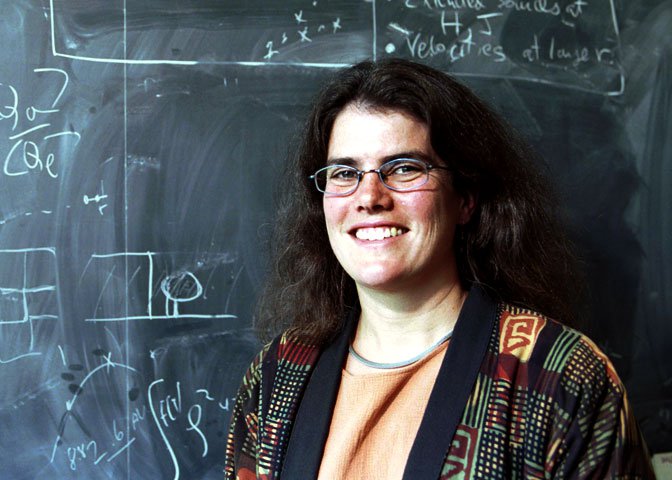 UCLA was home to groundbreaking research in the sciences, including one of the greatest discoveries of the century. In 2003, after decades of observations, professor of physics and astronomy Andrea Ghez and colleagues proved the existence of a supermassive black hole at the center of the Milky Way galaxy. The W.M. Keck Telescope atop Mauna Kea volcano in Hawaii uses adaptive optics to correct for atmospheric turbulence, allowing the team to see through space dust to the center of the galaxy, 24,000 light years away. Ghez was one of the youngest scientists elected into the National Academy of Sciences and became the first woman to win the Crafoord Prize from the Royal Swedish Academy of Sciences.
UCLA was home to groundbreaking research in the sciences, including one of the greatest discoveries of the century. In 2003, after decades of observations, professor of physics and astronomy Andrea Ghez and colleagues proved the existence of a supermassive black hole at the center of the Milky Way galaxy. The W.M. Keck Telescope atop Mauna Kea volcano in Hawaii uses adaptive optics to correct for atmospheric turbulence, allowing the team to see through space dust to the center of the galaxy, 24,000 light years away. Ghez was one of the youngest scientists elected into the National Academy of Sciences and became the first woman to win the Crafoord Prize from the Royal Swedish Academy of Sciences.
On Sept. 11, 2001, Los Angeles awoke to images of planes crashing into buildings following terrorist attacks which killed almost 3,000 people. At UCLA, the day was marked by sadness, fear and uncertainty. Two days later, a crowd of 5,000 gathered in Royce Quad for a memorial service to honor the victims, which included members of the UCLA community. Soon after, George W. Bush, the 43rd president of the United States, declared a “War on Terror” following the attacks.
In the days that followed, as students began arriving on campus to begin the school year, UCLA quickly organized 50 faculty-designed “Perspective on Sept. 11” seminars aimed at incoming students. Judith Smith, vice provost for undergraduate education in the College of Letters and Science, proposed the idea, saying, "This would be an opportunity for students to meet informally with faculty to talk about various perspectives of the issue." More than 650 students participated in courses addressing topics such as tolerance; terrorism and civil liberties; literature of war; trauma and its aftermath; and religion and politics in global society. Chancellor Albert Carnesale taught a seminar called "National Security in the 21st Century," telling the Daily Bruin, "The university is the principal institution to which we look for rational discourse of contemporary issues."
THE PROMISE OF UCLA
The economic downturn of 2008 cast a long shadow — staff were furloughed, tuition rose and students faced a depressed job market and an uncertain world. In spite of this, during the early part of the decade, Campaign UCLA was an unprecedented achievement in private fundraising. By 2005, Campaign UCLA officially had raised $3 billion, more than double the original goal, since launching in 1995. The campaign was the largest and most successful fundraising endeavor in the history of higher education.

Homecoming Parade
The groundbreaking research of UCLA professors continued to gain national attention. In 2006, Terence Tao was awarded the Fields Medal, often called the “Nobel Prize” for mathematics, “for his contributions to partial differential equations, combinatorics, harmonic analysis and additive number theory.” UCLA professor Tao is still solving some of the world's most challenging mathematical problems, including some that had been unsolved for decades.
In the field of economics, triple Bruin and native Angelino Elinor Ostrom ’54, M.A. ’62, Ph.D. ’65, became the first woman in 40 years to receive a Nobel Prize in Economics. Ostrom found that local communities manage shared natural resources in sustainable ways, disproving long-held theories.
ACTIVISM AND SOCIAL JUSTICE INITIATIVES
In 2001 and 2004, UCLA was once again listed as a “Top 10 Activist Campus” by Mother Jones magazine. UCLA encourages a culture of civic engagement, as many students participate for the first time. Across campus, Bruin Republicans protested racial preferences with an affirmative action bake sale, a tactic now used by student groups across the country.
In 2006, students decried UCLA police’s tasing of student Mostafa Tabatabainejad at Powell Library, by marching to UCPD headquarters. The following day, hundreds of students called for the overturning of Proposition 209, which banned affirmative action, outside the Regents’ meeting being held at Covel Commons. In 2009, a crowd of demonstrators rushed Covel Commons again, staged walkouts and occupied buildings to oppose the Regents’ proposed 32 percent student fee increase.

Tam Tran '06 and Cinthya Felix '07
In its continuing commitment to academic success, community service and social justice, the UCLA Cesar E. Chavez Department of Chicana and Chicano Studies was created in 2005, now the fastest growing department in the Social Sciences division.
The University also established partnerships with community organizations to help move initiatives forward. In 2002, UCLA partnered with California community colleges through the Center for Community Partnerships (CCCP), part of the “UCLA in LA” program to increase the competitiveness and diversity of the transfer pool — particularly first generation, low-income and historically underrepresented students. Llanet Martín ’04 said, “It helped me believe that a woman of color from a very, very modest home with immigrant parents, who really couldn’t help me navigate the system, could have a shot here.”

Community School
Students in the health sciences program at UCLA Fielding School of Public Health partnered with the Greater West Hollywood Food Coalition (GWHFC), serving individuals experiencing food insecurity, to bring medical assistance to West Hollywood’s homeless population in 2002. The volunteer-run Mobile Clinic Project (MCP), now in four locations, provides medical care, legal advocacy and compassionate connection.
THE BUILDING CONTINUES
UCLA expanded on campus as well as in the community. The Eli and Edythe Broad Art Center (formerly the Dickson Art Center) opened as the permanent home of the UCLA Department of Art and the UCLA Design/Media Arts Department in 2006, including the UCLA School of Arts and Architecture. The Broad Foundation, which works to advance entrepreneurship for the public good in education, science and the arts, provided $23.2 million for the construction of the center, designed by Richard Meier. The space is home to galleries, classrooms and studio space.

Spieker Aquatic Center
UCLA renewed its commitment to the best in patient care when, in 2008, it reopened the hospital in a brand new 10-story building, the largest building ever constructed in the UC system. Chancellor Block, who joined UCLA the same year, said, “Ronald Reagan Medical Center, with its revolutionary design and dazzling technology, was born of a partnership between the federal and state governments and the residents of Los Angeles — those who love UCLA, believe in its infinite capability and want to safeguard the well-being of Californians.”
Renowned architects I.M. Pei and C.C. Pei designed the open and light-filled building to include gardens, gathering places and windows that let in natural light. David T. Feinberg, chief executive of the UCLA Health System said, "This facility is historic, we have really created a place of healing."
One year later, on June 25, the hospital was the center of worldwide attention when Michael Jackson was rushed there after a drug overdose and pronounced dead.
SPORTS MILESTONES
UCLA sports teams had another stellar decade, becoming the first ever university to win 100 NCAA titles when the women’s water polo team won the 2007 NCAA Championship. Women’s water polo won their first NCAA national championship in 2001, led by an incredible roster of players, including Coralie Simmons ’01, Robin Beauregard ’03, Natalie Golda ’05, Kelly Rulon ’07 and Courtney Mathewson ’08. Once, when speaking at an event, Mathewson was asked how to pick the right college; she quickly replied, “Go to UCLA.” Women’s water polo won five championships in a row under head coaches Adam Krikorian ’97 and Brandon Brooks ’05, who took over in 2007.
The UCLA Women’s Gymnastics team won five national titles between 1997 and 2004. Competing under legendary coach Valorie Kondos-Field ’87, Bruin team members included 2000 Olympian Tasha Schwikert ’09, the first UCLA gymnast and seventh woman to win multiple NCAA all-around titles, her younger sister Jordan Schwikert ’09, and Kristen Ann Maloney ’05.

Russell Westbrook and Kevin Love
UCLA Football, on the other hand, played the role of spoiler on Dec. 2, 2006, with an incredible 13-9 upset of USC, preventing them from playing in the National Championship. The Bruins brought the Victory Bell back to Westwood after a seven-year losing streak to their arch rivals.
CUTTING-EDGE MEDICINE
UCLA Health Systems has been ranked by U.S. News & World Report as No. 1 in Los Angeles and No. 7 in the U.S., and “Best in the West” for 27 consecutive years. One reason for this can be attributed to a historic investment in 2002, made by entertainment magnate David Geffen, giving an unrestricted $200 million gift to the UCLA medical school, renamed the David Geffen School of Medicine at UCLA in his honor. On the opening of the school, Geffen said, “This new facility continues the university’s tradition of excellence and will attract some of the country’s brightest and most promising faculty and students.” This was the largest single donation of its kind to a school of medicine in the United States, and, at the time, was the largest donation ever made in the UC system.

Conjoined Alvarez Twins
That same year, Dr. Ronald Busuttil saved two patients on the donor list with a single donor when he performed the nation's first combined unrelated living liver transplant. Dr. Busuttil transplanted part of donor Doug Andrew's healthy liver to 29-year-old Jeff Cross, born with a genetically deficient liver. Cross’s liver was then transplanted to Lily Cheng, a single mother with liver cancer, extending the time to find a healthy donor. This surgery, called a "domino" transplant, expands the pool of potential donors. UCLA now has one of the largest liver transplant centers in the world, and has performed more than 6,000 transplants.
Throughout the decade, cutting-edge technology helped UCLA medical teams to be among the first to advance disease understanding and treatment. Cardiothoracic surgeons developed a less invasive technique to use an artery from the wrist in bypass surgery, called an endoscopic radial artery harvest. UCLA physicians Pierre Gobin and J.P. Wensel designed a device that could remove a blood clot from the brain known as the MERCI Retriever, which was approved by the FDA in 2004. And in 2005, UCLA became the world's first hospital to use an RP-6 robot, known as RONI (Robot of the Neuro ICU), in order for ICU physicians to virtually consult with a patient face to face and save precious time.
In 2007, UCLA Health launched Operation Mend in partnership with the United States military and the Department of Veterans Affairs to help heal the wounds of war. Operation Mend cares for military veterans with serious injuries at no cost to them. UCLA’s long dedication to veterans began at the end of World War II with a partnership with the U.S. Veterans Administration.
PIONEERS IN SCIENCE

Professor Andrea Ghez
In 2007, Adam Cheyer, M.S. ’93, and his colleagues co-founded the startup named Siri. Together they launched “the first true automated Virtual Personal Assistant for mobile devices.” They later sold the company to Apple in a deal estimated at about $200 million.
In 2000, California Gov. Gray Davis announced the creation of the California NanoSystems Institute (CNSI), an enterprise for research supported through public-private partnerships in biomedicine, bioengineering, nanosystems, telecommunications and information technology. The joint UCLA and UC Santa Barbara venture has advanced understanding in health, energy, the environment and information technology. Scientists conduct interdisciplinary research at the atomic and molecular level — chemists, physicists and neurologists map the brain with nanoelectronic sensors; environmental scientists purify water using nanobiotechnology; and oncologists use nanomedicine to create innovative cancer treatments.
LOOKING FORWARD
Megan Jensen ’08 recalls that her college experience was marked by the incredible amount of enriching opportunities and activities that were available at UCLA. She says, “UCLA shaped the person I am in every way, and the lens through which I see the world. It’s a testament to the dynamism and the diversity of the population of the university.” Jensen was a very active and engaged student, participating in study abroad, Unicamp and tutoring, and was a volunteer copy editor for the Daily Bruin. An English major with a minor in global studies, Jensen found herself motivated by her fellow students, and encouraged to learn and grow from the experience. Although she and her classmates graduated into a global recession, she says many students found creative ways to work in unique job opportunities — including AmeriCorps and Teach for America.
Jensen echoed the promise of UCLA in the new 21st century, where it rose in stature as the most applied-to university in the country. As the University entered the 2010s, UCLA remained a standard bearer of excellence in education, research and service, and would soon replace its northern branch and assume the mantle of No. 1 public university. The next era was marked with unexpected disruptions from fires to floods to a campus shooting, perhaps preparing UCLA for the unprecedented disruptions which lay ahead in 2020.